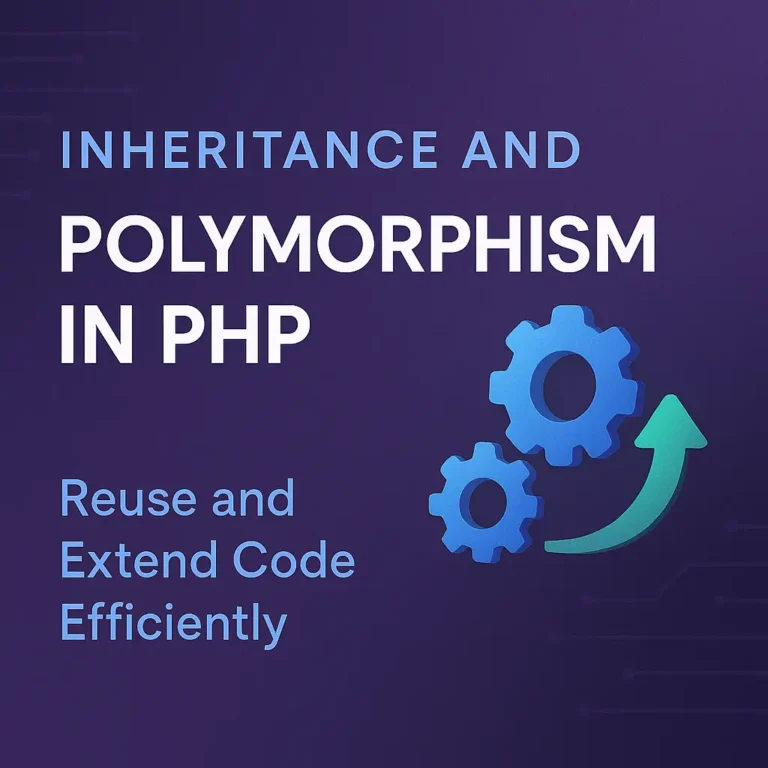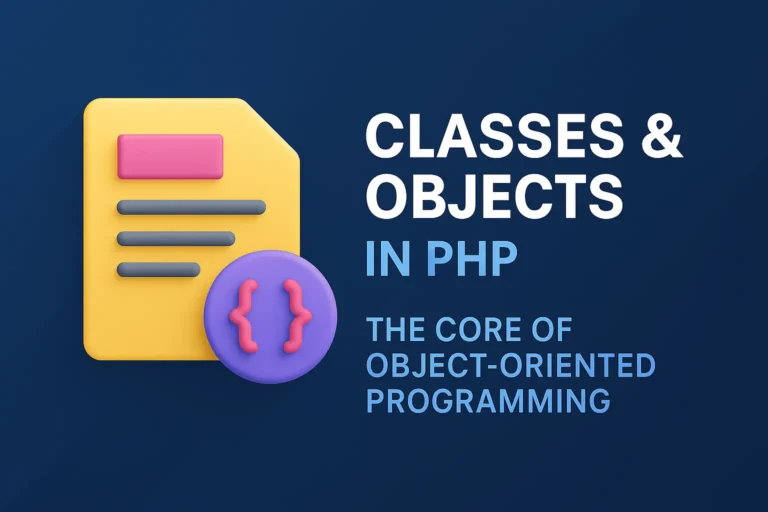In this comprehensive guide, we’ll explore the fundamentals of object-oriented PHP, including classes, objects, constructors, and destructors. Through detailed explanations and practical code examples, you’ll gain a solid understanding of OOP principles and learn how to apply them effectively in your PHP projects.
Classes and Objects
In object-oriented PHP, a class is a template or blueprint for creating objects. It defines the properties (attributes) and methods (functions) that objects of that class will have. An object is an instance of a class, representing a specific entity or concept in your application.
Defining a Class
<?php
// Define a class
class Car {
// Properties
public $brand;
public $model;
// Methods
public function drive() {
echo "The $this->brand $this->model is driving.";
}
}
?>
In this example, we define a Car class with two properties (brand and model) and a method (drive). Properties represent characteristics of the object, while methods represent actions or behaviors.
Creating Objects
<?php
// Create objects of the Car class
$car1 = new Car();
$car1->brand = "Toyota";
$car1->model = "Corolla";
$car2 = new Car();
$car2->brand = "Honda";
$car2->model = "Civic";
?>
In this example, we create two objects ($car1 and $car2) of the Car class using the new keyword. We then set the values of the properties (brand and model) for each object.
Constructors and Destructors
Constructors and destructors are special methods in PHP classes that are automatically called when an object is created (instantiated) or destroyed (when no references to it exist), respectively.
Constructors
A constructor is a method that is called automatically when an object is created. It is used to initialize object properties or perform any necessary setup tasks.
<?php
class Car {
public $brand;
public $model;
// Constructor
public function __construct($brand, $model) {
$this->brand = $brand;
$this->model = $model;
}
public function drive() {
echo "The $this->brand $this->model is driving.";
}
}
$car = new Car("Toyota", "Corolla");
?>
In this example, we define a constructor __construct() that takes two parameters ($brand and $model) and initializes the corresponding properties of the object.
Destructors
A destructor is a method that is called automatically when an object is destroyed. It is used to perform any cleanup tasks, such as releasing resources or closing database connections.
<?php
class Car {
// Properties and methods...
// Destructor
public function __destruct() {
echo "The $this->brand $this->model is being destroyed.";
}
}
$car = new Car("Toyota", "Corolla");
unset($car); // Destroy the object
?>
In this example, we define a destructor __destruct() that echoes a message indicating that the object is being destroyed. We then use the unset() function to destroy the object explicitly.
Best Practices
Follow Naming Conventions: Use meaningful names for classes, properties, and methods to improve code readability and maintainability.
Encapsulate Logic: Encapsulate related properties and methods within classes to promote modularity and encapsulation.
Use Constructors Wisely: Use constructors to initialize object properties and perform setup tasks, but avoid complex logic that could lead to tight coupling.
Implement Destructors Sparingly: Use destructors sparingly and only for cleanup tasks that are absolutely necessary, as PHP’s garbage collection usually handles resource cleanup automatically.
Conclusion
Object-oriented PHP enables developers to create modular, maintainable, and scalable applications by organizing code into classes and objects. In this guide, we explored the fundamentals of object-oriented PHP, including classes, objects, constructors, and destructors. We learned how to define classes and create objects, as well as how to use constructors to initialize object properties and destructors to perform cleanup tasks. By mastering these concepts and following best practices, you can leverage the power of object-oriented PHP to build robust and flexible applications that meet the needs of your users effectively.
<?php
// Example PHP code demonstrating object-oriented PHP
class Car {
// Properties
public $brand;
public $model;
// Constructor
public function __construct($brand, $model) {
$this->brand = $brand;
$this->model = $model;
}
// Method
public function drive() {
echo "The $this->brand $this->model is driving.";
}
}
// Create an object of the Car class
$car = new Car("Toyota", "Corolla");
$car->drive(); // Output: The Toyota Corolla is driving.
?>
This PHP script demonstrates the creation of a Car class with properties (brand and model), a constructor to initialize the properties, and a method (drive) to perform an action. An object of the Car class is created, and the drive method is called to output a message indicating that the car is driving.






